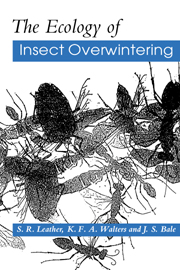3 - The stimuli controlling diapause and overwintering
Published online by Cambridge University Press: 16 September 2009
Summary
Introduction
Insects show a range of responses to the deteriorating environmental conditions that occur as winter approaches. These responses include migration, diapause, polymorphism and dormancy. Whichever response or set of responses the insects (and mites) employ it is important that the developmental stage in which they overwinter (see Chapter 5) is reached at precisely the correct time of year, and they use a variety of seasonal stimuli to keep their life cycles synchronised with the environmental conditions they are experiencing. This chapter considers the abiotic and biotic stimuli that insects use both to detect the forthcoming harsh conditions of winter and to determine the duration of the overwintering state.
Although only a minute proportion of the species that overwinter in temperate areas have been studied, the degree to which individual species rely on seasonal cues indicating the onset of winter already shows a wide variation from complete environmental control at one end of the continuum to genetic control at the other (Tauber et al. 1986). The subject is further complicated by the range of token stimuli employed. Photo-period and thermoperiod frequently act as cues for the control of overwintering but other factors such as moisture, nutrition and, in parasitoids, the physiology of the host, have also been shown to have an influence. The way in which these stimuli act also varies between species. For example, some insects respond to the relative duration of the two phases of thermoperiod (see p. 36), whereas in others the lowest temperature reached in relation to a critical level is important.
- Type
- Chapter
- Information
- The Ecology of Insect Overwintering , pp. 25 - 74Publisher: Cambridge University PressPrint publication year: 1993
- 1
- Cited by



